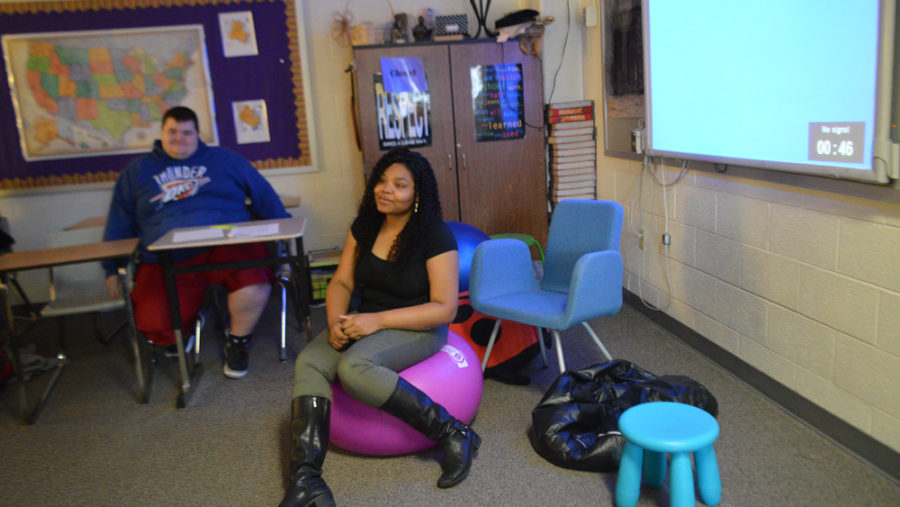A Focus on Flexible Seating
Offering students flexible or alternative seating styles in classrooms may improve learning environment
Our world is constantly advancing and improving itself. Through its advancement, many ideas come and go. One of the latest ideas for educational improvement is flexible seating. This is a recent educational theory in which students can sit on a surface other than a traditional chair – some seating options include Bosu balls, beanbag chairs, or even a stool.
Flexible seating adds the element of a personalized learning environment, something English teacher Marty Ryman believes benefits her students.
“I notice the kids get really excited about what they’re saying, they seem more animated. They seem, I don’t know, they seem happier. They seem more willing to engage in conversation because they feel free, more independent,” said Ryman.
Students get the choice to sit on a surface or in an area that they believe will help them learn best. With this practice, many students can feel comfortable and be more focused on learning.
“I like [flexible seating] because I can sit closer to my friends, and I can see the board easier since I sit in the back behind a lot of people,” said freshman Sophia Castor. “It gives you more community than it would if you’re required to sit somewhere. If you want to sit somewhere near somebody, you most likely will be more productive and want to do your work in a setting where you would like to sit.”
Smith System, a company that focuses solely on designing flexible seating for K-12 classrooms, believes that “a flexible-seating classroom is anything but a dull, uniform row of identical chairs and desks. Rather, there are various types of seating spread throughout the room,” according to their website. “They vary in shape, height, material and motion, and will include a few traditional choices, as well. Typically, students decide their spot on a rotation basis. Clearly posted classroom rules help keep the harmony.”
At our school, English teachers Leah Hawley and Ryman have incorporated this type of setup in their classroom, something they started doing this school year. Both teachers feel that it has benefitted their students in ways that a standard classroom cannot.
“As an English teacher, I need my students to feel comfortable enough that they’re more willing to discuss and participate in class. By having a more laid-back environment, my hope was that the students would feel at home allowing them to discuss more openly,” said Hawley.
Elementary schools are the typical environment for flexible seating because it is believed that younger students can develop good habits early and be more likely to continue them as they get older. However, this method of teaching can be used at any age.
“I actually find [flexible seating] to be more effective for my seniors because there is more drafting then full on instruction, so there is less instruction time and more independent study time. Because of that, I find them using it more frequently than my other classes,” said Hawley.
According to Learningstyles.org, kinesthetic learners benefit most from flexible seating because they learn best through movement and touch. Kinesthetic learners, more than visual or auditory learners, may have trouble focusing in a classic classroom set up because they want to get up and move around.
“I like being able to be in a more comfortable spot,” said freshman Maria-Jose Lemma. Although she enjoys flexible seating, she says sometimes she can become distracted, just like in any other class. But, overall, she enjoys it.
Room 228’s transformation happened at the end of last year. Both teachers realized how much the spacious room had to offer. “It was actually Mrs. Hawley’s idea, and she said maybe we could do some more options with flexible seating, which I love because last year we kind of redecorated, so it had more of a chill vibe. I said ‘let’s do it,’ and that’s how it sort of came to be,” said Ryman.
Like many other teachers across the nation, Hawley and Ryman had transformed their average classroom into a laid back “coffee shop” environment, but they didn’t do it alone. They reached out to the panther community and asked for donations for the classroom and got plenty of responses. Most of the different seating was donated by the community and didn’t cost the school money.
“I always think it’s good, and Mrs. Hawley agrees, to give kids choices or options. So, it’s nice. Some days kids sit on the Bosu balls; some days they lay their head on a pillow and read their book. Some kids utilize it, some choose not to, and that’s fine too,” said Ryman.
Typical seating options used here and around the world include the following
-Bosu balls
-Couches
-Blankets
-Rugs
-Pillows
-Bean bag chairs
-Saucer chairs
-Bungee chairs
-Camping chairs
-Stools
-Mats


